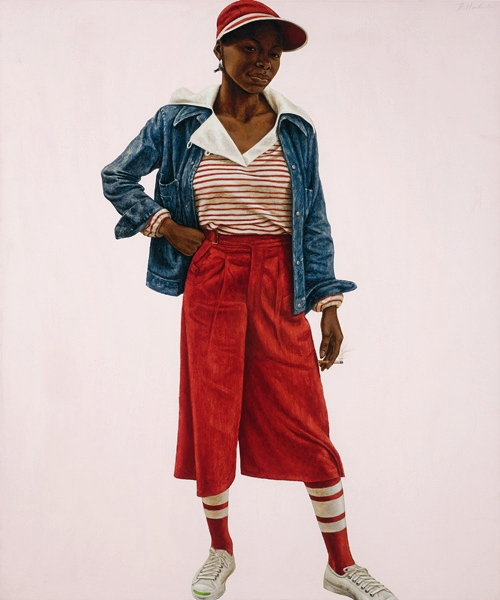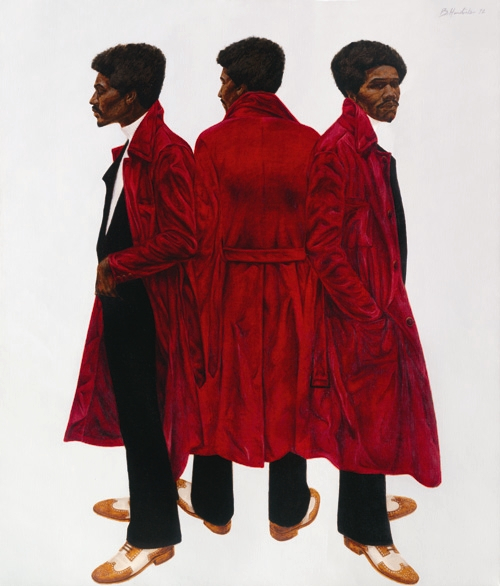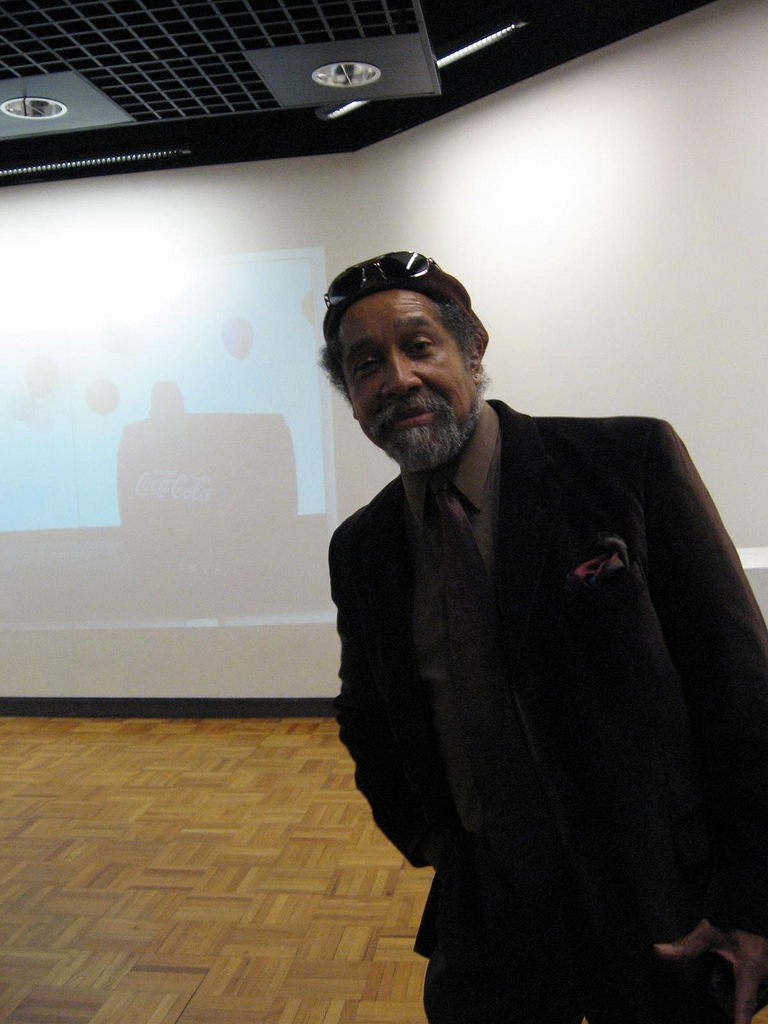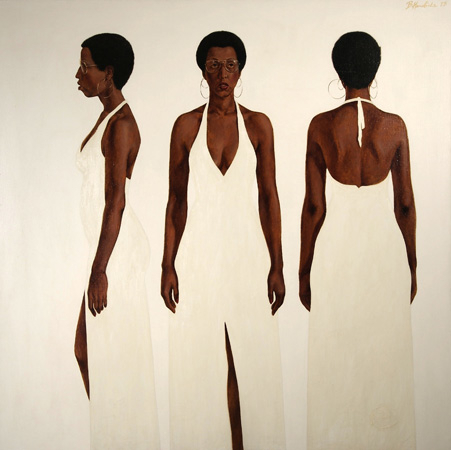Bashir, Jules, Tuff Tony and Angie wouldn’t stand out in a crowd. But in Barkley Hendricks’ “Birth of the Cool” at Pennsylvania Academy of the Fine Arts, these seemingly ordinary people, depicted in nearly life-size paintings, become new icons for a secular age. The works have such a sense of stillness that they feel almost like religious images.

Which is not to say these people are saints. While the Philadelphia-born Hendricks—trained at the Academy (certificate, 1967) and at Yale (MFA, 1972)—uses the conventions of religious painting (gold leaf in several works and a halo above Fela Kuti in another), these figures have attitude. Their body language is confrontational. They smoke. They blow bubblegum in your face. Kuti grabs his crotch; Tuff Tony scowls; hardly anybody smiles in these portraits. Hendricks serves up a new paradigm for the high art portrait: Instead of wealthy folks, he depicts ordinary people who lead complicated lives, have struggles and are worthy of contemplation.
It’s a highly political move and while Kehinde Wiley and Jeff Sonhouse are following in Hendricks’ footsteps it is Hendricks’ works that blaze the trail with empowered images of African-Americans and a celebration of the black fashion sensibility.
I talked with Hendricks last month when the show opened. It should be no surprise that the artist loves his camera as well as his paints, brushes and canvas. Hendricks has been photographing people since his days as a student at PAFA. Check out a selection of his photos at the African American Museum through Jan. 3.
When I arrived at PAFA to interview Barkley Hendricks, he was in the gallery video-documenting his show, something he likes to do. It was my first clue that the painter is also a whiz with cameras.
Where did you show your work in Philadelphia when you first started out?
Kenmore Gallery–18th and Chestnut. It was run by Harry Kulkowitz. It’s defunct now. Then I moved to NY and showed at ACA gallery for years. Recently at The Project….for 2-3 years. Now I’m with Shainman Gallery.
Keeping track of your work is hard when you’ve had relationships with many galleries. Do you have lists of titles and owners…or maybe the galleries have that?
Whether or not you’re important has to do with whether they have lists.
Harry Kulkowitz, he picked me up right out of school. It was my third year when I got the Cresson traveling scholarship. 1967 is when I got my certificate from PAFA. Harry came to see the exhibit and we started a relationship. I showed at Kenmore until 1973 or 74. I had a couple solo shows. Harry was a native New Yorker and thought beyond the boundaries of Philly. He worked his network in New York…got me my first Whitney and some group shows there. I credit Harry for that.

How were sales?
I had reached the $5,000 ceiling that black artists have, in 67 or 68. Someone said that once (that there is a $5,000 ceiling for black artists).
Your work is political.
I’m about painting people and unfortunately we have a stratified world. Only recently I’ve been on the radar. I was under or nowhere near the radar before.
I asked my students (at Connecticut College where he has taught since 1972) have you ever heard of the Guerilla Girls. They said no. I told them about them. I respect them tremendously. They dealt with the problem of the status quo and white male dominated world.
What do you think about the separating of art by race or gender in separate museums like the Women’s Museum in Washington or the African American Museum in Philadelphia?
It has to do with education and community. Thirty or 40 years ago we didn’t have anything like it [a museum that tells the story of African American art and culture]. Richard Watson is my very good friend…he works there. He sometimes has issues with the museum. Is it an art museum or a cultural institution? It needs to be both. Maybe down the road [you can do away with the need for separate ethnic museums]. But there’s a need of cultures to acknowledge their own and honor them]..like Gorky and Armenian pride.”

Would you paint President Obama?
(laughs) I get that question all the time. I’ll tell you what I tell everyone. Maybe. I’m not opposed to it. But I don’t seek out celebrities. I painted Kuti and I’ve photographed a certain number of celebrities. I’ve been photographing jazz musicians in clubs and backstage.
Tell me about photographing musicians – who have you photographed?
Miles Davis, Dizzy Gillespie, Sonny Rollins, Dexter Gordon, Charles Mingus, Modern Jazz Quartet, Oscar Brown Junior, Carmen McRea, Diane Reeves, Herbie Hancock.
You shoot film in dark jazz clubs? You must have a very steady hand.
Here’s a story for you. Here in Philly I went to the Showboat. Cannonball Adderly was playing. There was a roving photographer taking Polaroid photos of the couples in the audience . I asked him to take a shot of Cannonball ….and it was a piss poor shot. And I thought…if you want it you better do it yourself. So when I got the Cresson (the travel scholarship at PAFA), people said you have to take a camera. I bought a Rangefinder….and then an SLR…and then I had the equipment to move into clubs.
So very early on you’re working with a camera.
It’s dealing with how to see. “Think before you click the shutter” ….pre-visualization. At Yale I hung out more with the photographers than with the painters. They were working with 4×5’s, and [light] metering and setting up. I had a 4×5 and also a 2 1/2 x 2 12 Hasselblad. But 35 MM was faster and I could take it into places and shoot. I recently started using a flash. Not always…it can get you kicked out of some places.
I’ll tell you a story. Miles Davis was playing in New York. If you know about Miles you know he had his back to the audience when he played. Some people thought he was [elitist]…but no, he said he was about getting the music out. He’d play so you would see his band. I was backstage so i was facing him. I squeezed off 4 to 5 rolls of film. Then I got a tap on the shoulder. It was one of Miles’ roadies. “Miles said get off the stage.”
I went backstage after the concert. Miles is a painter. I gave him a catalog [of my work]. I said ‘I play the trumpet. I play the trumpet as well as you paint. And you play the trumpet as well as I paint.’ He smiled.

I know that you took a photography class with Walker Evans at Yale. Tell me about that.
I did a portfolio on the NY Port Authority. It helped me get into Walker Evans’ advanced photography class. At Yale, there were 14 people in grad school. two or three representational painters, the rest were what I call “pour painters” like Helen Frankenthaler. They poured paint. They were nice guys but I had more contact with the photographers. I was leaning photo stuff…printing, tinting, etc.
Let’s talk about fashion. You have taken photos at fashion shows. Have you ever walked the runway yourself–you dress very fashionably and your painting, Slick, is yourself as a fashion plate.
I haven’t been in a fashion show. But every time you step outside your door you’re on a fashion runway. The streets are a runway.
Tell me about the trumpet. Do you play with a group?
Our group is called “Other Issues.” We all had scheduling issues…one member, his mom died. the bass player had hand issues; another had domestic issues; I had issues….I also play drums.
Did you take lessons? and did you pick this up as an adult?
I picked it up. As an adult. about 20 years ago (when he was in his 40s).
Here’s a story. I had a friend who was a thug. He came by the studio and said “Hey, butch, I have this trumpet, want it for $50? I said no, but how about $40. I got it and it had no mouthpiece so I went and bought a mouthpiece and blew and blew and got no sound out of it. So I did a painting of the trumpet and sold the painting and the trumpet and got another trumpet. –and had success with it. And I graduated to a master trumpeter in upstate NY (his wife is from upstate NY). He makes mouthpieces for me…from wood. It feels great on the lips in the winter!
Hendricks had a carpentry accident this summer. He was building a frame for a painting and the router backfired and jumped up and hit his right arm and made a deep cut. The aftermath of the accident affects his trumpet playing since he can’t feel his fingertips on the keys.
That must be awful all round. You’re right handed. Does it affect your painting too?
(He’s always been ambidextrous painter. If he’s working one area of a painting and sees something on the left side of the painting he’ll take a brush in his left hand and work it.)
I’m not a finish painter with the left hand but I can do it. I’m hoping for some regeneration (in his hand/arm)…If I was in my 20s…Now I’m in my 60s so regeneration is an issue.
You do your own framing. You must know your way around carpentry tools.
My father was a contractor. We did everything imaginable to a house. We had a dubious relationship when I was a kid but I took [the knowledge of tools] to the studio. I have a love/hate relationship to tools. I get a lot now at yard sales. I have 8 or so routers and a table saw. I have tools up the yin yang.
Barkley Hendricks: “Birth of the Cool.” Through Dec. 20, 2009. Pennsylvania Academy of the Fine Arts, Hamilton Building, 118 N. Broad St.
This is an expanded version of a feature that ran in Philadelphia Weekly.





